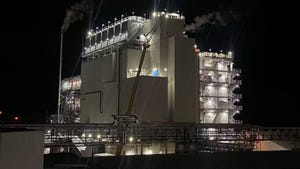Phosphate flame retardants keep pace with needs of transport sector
Clariant (Muttenz, Switzerland) says it is making fire safety and sustainability a realistic and achievable goal for transportation applications with its cost-efficient, non-halogenated flame retardant solutions. Exolit AP ammonium polyphosphate-based and Exolit OP phosphinate-based flame retardants for thermoset systems reportedly address the key challenges of modern vehicle manufacture, with its increasing trend toward lightweight structual parts.
March 25, 2014

Clariant (Muttenz, Switzerland) says it is making fire safety and sustainability a realistic and achievable goal for transportation applications with its cost-efficient, non-halogenated flame retardant solutions. Exolit AP ammonium polyphosphate-based and Exolit OP phosphinate-based flame retardants for thermoset systems reportedly address the key challenges of modern vehicle manufacture, with its increasing trend toward lightweight structual parts.
|
Non-halogenated flame retardants for transport applications function in low dosages. |
These flame retardants for unsaturated polyester and epoxy resins support the aviation, road, rail and shipping sectors in fulfilling today's stricter flammability requirements, meeting environmental targets through the use of materials with corresponding health and environmental profiles, and in achieving greater cost-efficiency without compromising on fire protection and hazard levels. Their advantage reportedly lies in their effectiveness for composites and laminates, which enables very low concentrations to be used, while at the same time meeting stringent flammability requirements.
"The transport sector is faced with a number of rising challenges as stricter flammability and emissions requirements meet the trend toward lightweight parts and demand for manufacturing cost efficiency," comments Adrian Beard, Head of Marketing Flame Retardants at Clariant. "Clariant's halogen-free, sustainable retardants are able to achieve high flammability requirements and therefore present effective, efficient alternatives to materials such as decabromo diphenylether (Deca-BDE) for rolling stock, airplanes and beyond."
Available for sole use or as synergistic formulations with aluminium hydroxide (ATH), Exolit AP enables thermoset resins used in fiberglass reinforced composites to reach high flammability requirements and fire standards such as under the new EU wide railway standard EN 45545-2 for interiors. With Exolit flame retardants the customer can prepare composites and laminates which fulfil the Hazard Level (HL) 2 and HL 3 requirements under EN 45545-2. Composites with the halogen-free Exolit flame retardants show advantages in smoke toxicity measurements (EN ISO 5659-2) and have in addition low heat release rates. If tested under ISO 5660-1 in the cone calorimeter, the required low MARHE (Maximum Average Rate of Heat Emission) numbers for HL 2 ad HL 3 can be reached.
In addition, Exolit grades can be used to formulate intumescent (gel)-coats which drastically improve the fire endurance of the entire composite part. Exolit flame retardants are suited to traditional hand lay-up process, as well as pultrusion and other advanced techniques. For electrical markets, all Exolit products are fully compliant with current WEEE and RoHS regulations (European Directives on Waste Electrical and Electronic Equipment and Restriction of certain Hazardous Substances in Electric and Electronic Equipment). For thermoset systems, Exolit AP grades allow low smoke density and do not release corrosive gases.
About the Author(s)
You May Also Like



